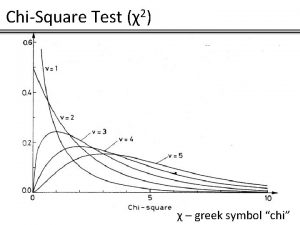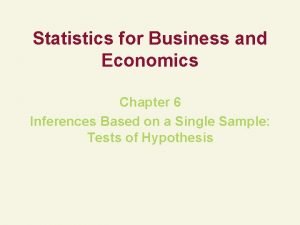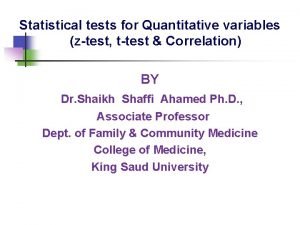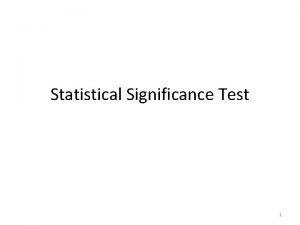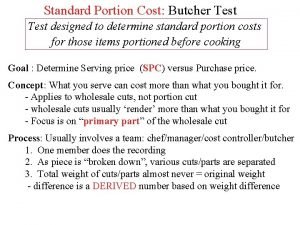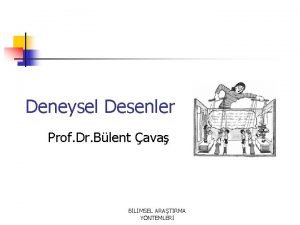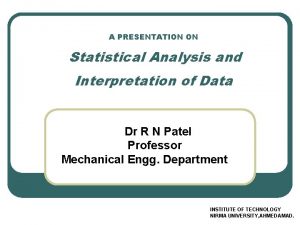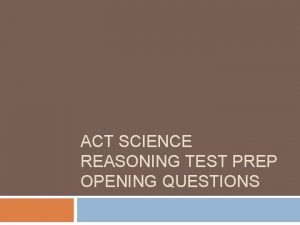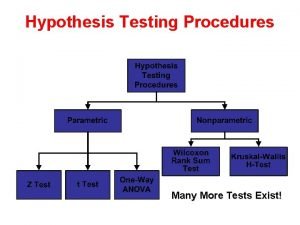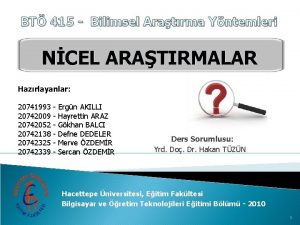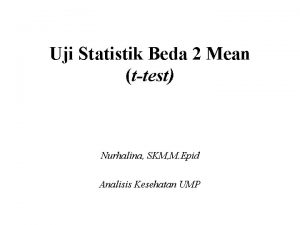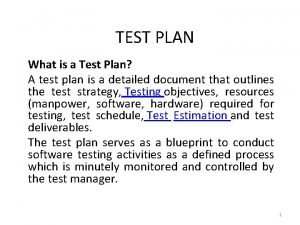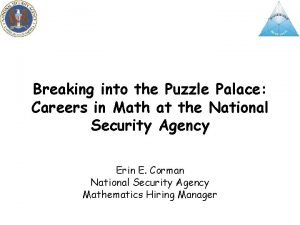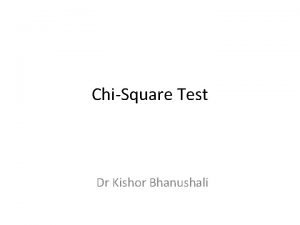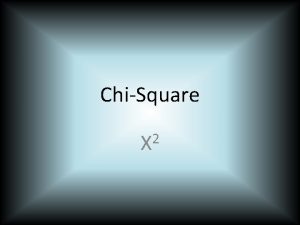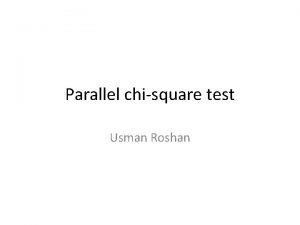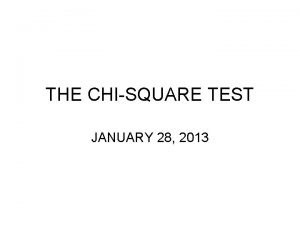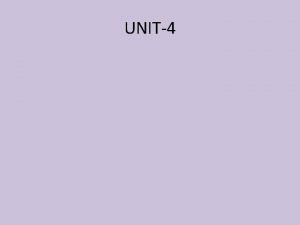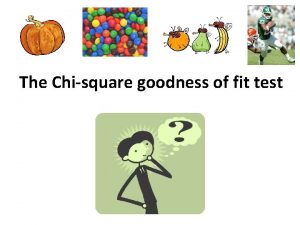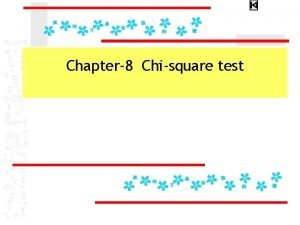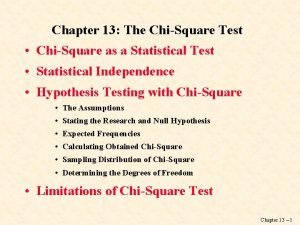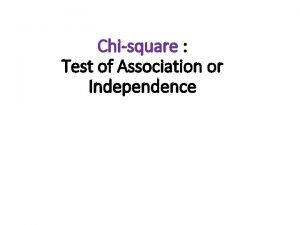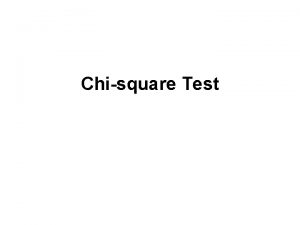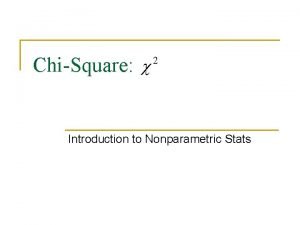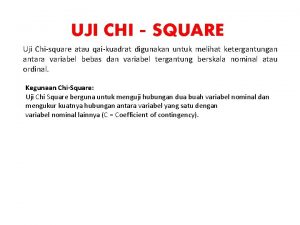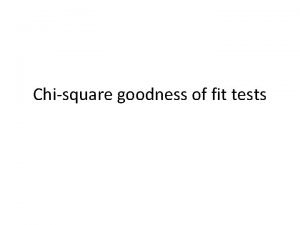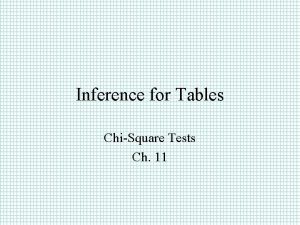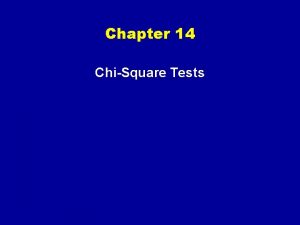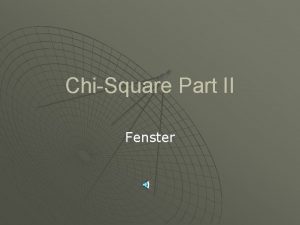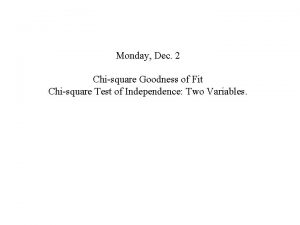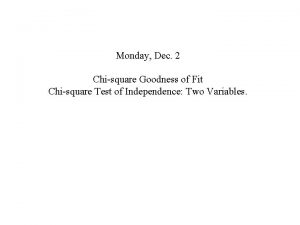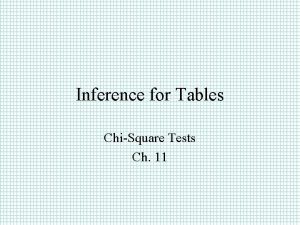Chisquare test or 2 c test Chisquare test






























- Slides: 30

Chi-square test or 2 c test

Chi-square test • Used to test the counts of categorical data • Three types – Goodness of fit (univariate) – Independence (bivariate) – Homogeneity (univariate with two samples)

2 c distribution – df=3 df=5 df=10

2 c distribution • Different df have different curves • Skewed right • As df increases, curve shifts toward right & becomes more like a normal curve

2 c Goodness of fit test • Uses univariate data df = number of categories - 1 • Want to see how well the observed counts “fit” what we expect the counts to be • Use c 2 cdf function on the calculator to find p-values Based on df –

c 2 assumptions • SRS – reasonably random sample • Have counts of categorical data & we expect each category to happen atthese Combine together: least once All expected • Sample size – to insure thatcounts the are at sample size is large enough weleast should 5. expect at least five in each category. ***Be sure to list expected counts!!

Hypotheses – written in words H 0: proportions are equal Ha. H: 0 at one is not : theleast proportions fit aproportion theoretical the same model HA: At least one of the proportions is different from theoretical Be sure model. to write in context!

2 c formula

Does your zodiac sign determine how successful you will Note: You magazine will be using logic findsigns of 256 be? Fortune collected theto zodiac heads of thecounts. largest 400 Is there expected If companies. the question asks if sufficient evidence to claim that successful people are something is equally likely, you simply take more likely to be born under some signs than others? the total sample size and divide by the Aries Libra Leo a 20 number of 23 categories. If 18 you have theoretical 20 model, (for instance, 20% are 19 Taurus Scorpio 21 Virgo Leos) then 18 you Sagittarius take the total Gemini 19 sample Aquariussize 24 and multiply by. 20. Read the problems Cancer 23 Capricorn 22 Pisces 29 carefully to decide to find I would expect CEOs tohow be equally born the under all signs. expected counts. Soare 256/12 = 21. 333333 Since there 12 signs – How manydfwould = 12 you – 1 expect = 11 in each sign if there were no difference between them? How many degrees of freedom?

Assumptions: • Have a random sample of CEO’s • All expected counts are greater than 5. (I expect 21. 33 CEO’s to be born in each sign. ) H 0: The proportions of CEO’s born under each sign are the same. Ha: At least one of the proportion of CEO’s born under each sign is the different. P-value = c 2 cdf(5. 094, 10^99, 11) =. 9265 a =. 05 Since p-value > a, I fail to reject H 0. There is not sufficient evidence to suggest that the CEOs are born under some signs than others.

A company says its premium mixture of nuts contains 10% Brazil nuts, 20% cashews, 20% almonds, 10% hazelnuts and 40% peanuts. You buy a large can and separate the nuts. Upon weighing them, you find there are 112 g Brazil nuts, 183 g of cashews, 207 g of almonds, 71 g or hazelnuts, and 446 g of peanuts. You Because we do NOT wonder whether your mix ishave significantly counts of the different from what the company type advertises? of nuts. Why NOT We could count the number is the chi-square goodness-of-fit of each type of nuttest and appropriate here? then perform a c 2 test. What might you do instead of weighing the nuts in order to use chi-square?

Offspring of certain fruit are flies may have Since there 4 categories, yellow or ebony bodies and normal wings or df = 4 –predicts 1 = 3 short wings. Genetic theory that Expected these traits willcounts: appear in the ratio 9: 3: 3: 1 & N = 56. 25 (yellow &Y normal, yellow & short, ebony & Y & S = 18. 75 normal, ebony & short) A researcher checks E & N = 18. 75 100 such Eflies finds the distribution of We expect 9/16 of the 100 & S and = 6. 25 traits to be 59, 20, 11, andto 10, respectively. flies have yellow and normal wings. (Y & N) What are the expected counts? df? Are the results consistent with theoretical distribution predicted by the genetic model? (see next page)

Assumptions: • Have a random sample of fruit flies • All expected counts are greater than 5. Expected counts: Y & N = 56. 25, Y & S = 18. 75, E & N = 18. 75, E & S = 6. 25 H 0: The proportions of fruit flies are the same as theoretical model. Ha: At least one of the proportions of fruit flies is not the same as theoretical model. P-value = c 2 cdf(5. 671, 10^99, 3) =. 129 a =. 05 Since p-value > a, I fail to reject H 0. There is not sufficient evidence to suggest that the distribution of fruit flies is not the same as theoretical model.

A radio station reported the following music preferences from a nationwide survey: Distribution of Percent Music Preferences Preferring Classical 4% Rap 36% Gospel 11% Oldies 2% Pop 18% Rock 29% The following results on the board were obtained from a survey of 500 individuals in Georgia. Is there evidence to suggest the people in Georgia have similar music preferences as the nationwide survey.

2 c test for independence • Used with categorical, bivariate data from ONE sample • Used to see if the two categorical variables are associated (dependent) or not associated (independent)

Assumptions & formula remain the same!

Differences • Statements address independence • Finding expected values will still require logic but there is a formula • Formula for df changes

Hypotheses – written in words H 0: two variables are independent Ha: two variables are dependent Be sure to write in context!

A beef distributor wishes to determine whethere is a relationship between geographic region and cut of meat preferred. If there is no relationship, we will say that beef preference is independent of geographic region. Suppose that, in a random sample of 500 customers, 300 are from the North and 200 from the South. Also, 150 prefer cut A, 275 prefer cut B, and 75 prefer cut C.

If beef preference is independent of geographic region, how would we expect this table to be filled in? North South Total Cut A 90 60 150 Cut B 165 110 275 Cut C 45 30 Total 300 200 75 500

Still not sure how we got those numbers, TRY THIS! Expected Counts • Assuming H 0 is true, expected counts can be found using:

Degrees of freedom Or cover up one row & one column & count the number of cells remaining!

Now suppose that in the actual sample of 500 consumers the observed numbers were as follows: Cut A Cut B Cut C Total North 100 150 50 300 South 50 125 25 200 Total 150 275 75 500 Is there sufficient evidence to suggest that geographic regions and beef preference are not independent? (Is there a difference between the expected and observed counts? )

Assumptions: Expected Counts: • Have a random sample of people N S • All expected counts are greater than 5. A 90 60 B 165 C 45 110 30 H 0: geographic region and beef preference are independent Ha: geographic region and beef preference are dependent P-value =. 0226 df = 2 a =. 05 Since p-value < a, I reject H 0. There is sufficient evidence to suggest that geographic region and beef preference are dependent.

2 c test for homogeneity • Used with a single categorical variable from two (or more) independent samples • Used to see if the two populations are the same (homogeneous)

Assumptions & formula remain the same! Expected counts & df are found the same way as test for independence. Only change is the hypotheses!

Hypotheses – written in words H 0: the proportions for the two (or more) distributions are the same Ha: At least one of the proportions for the distributions is different Be sure to write in context!

The following data is on drinking behavior for independently chosen random samples of male and female students. Does there appear to be a gender difference with respect to drinking behavior? (Note: low = 1 -7 drinks/wk, moderate = 8 -24 drinks/wk, high = 25 or more drinks/wk)

Men None Low Moderate High Total Women 140 478 300 63 981 Total 186 661 173 16 1036 326 1139 473 79 2017

Expected Counts: Assumptions: • Have 2 random sample of students M F 0 158. 6 167. 4 • All expected counts are greater than 5. L 554. 0 585. 0 M 230. 1 243. 0 H 38. 4 40. 6 H 0: the proportions of drinking behaviors is the same for female & male students Ha: at least one of the proportions of drinking behavior is different for female & male students P-value =. 000 df = 3 a =. 05 Since p-value < a, I reject H 0. There is sufficient evidence to suggest that drinking behavior is not the same for female & male students.
 Chi square greek symbol
Chi square greek symbol Objective vs subjective
Objective vs subjective Www.123 test.com/disc-personality-test/
Www.123 test.com/disc-personality-test/ Latent squint meaning
Latent squint meaning Intermittent exotropia
Intermittent exotropia What is the ha
What is the ha Z test and t test
Z test and t test Univariate analysis tests
Univariate analysis tests 2 sample t test formula
2 sample t test formula Butcher test example
Butcher test example When do we use z test or t test
When do we use z test or t test Nonparametric tests
Nonparametric tests De 4 kundetyper
De 4 kundetyper Sontest kontrol gruplu model
Sontest kontrol gruplu model 123 test.com/career-test
123 test.com/career-test When to use z test and t test
When to use z test and t test Www.123 test.com/disc-personality-test/
Www.123 test.com/disc-personality-test/ Achievement test and aptitude test
Achievement test and aptitude test Practice test 1 science reasoning test
Practice test 1 science reasoning test Algebra 2 unit 1 practice test
Algebra 2 unit 1 practice test 123 test.com/career-test
123 test.com/career-test Mann-whitney u test vs t-test
Mann-whitney u test vs t-test Wall toss test advantages and disadvantages
Wall toss test advantages and disadvantages Limit comparison theorem
Limit comparison theorem Seçkisiz atama nedir
Seçkisiz atama nedir Public class test subject extends test class
Public class test subject extends test class 123 test.com/career-test
123 test.com/career-test Contoh uji t berpasangan
Contoh uji t berpasangan Test strategy includes
Test strategy includes Endotoxin vs enterotoxin
Endotoxin vs enterotoxin Nsa mathematics proficiency test practice test
Nsa mathematics proficiency test practice test
